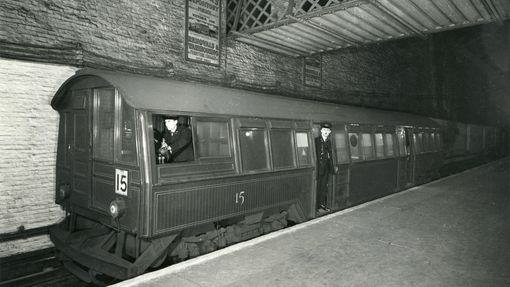
The Central line
Keys facts
Length: 74km
Stations: 49
Opened: 1900
Introduction
The Central line opened as the Central London Railway in 1900. Today it runs from Epping in suburban Essex through central London to the west London suburbs at Ealing Broadway and West Ruislip. Services have changed very little since the late 1940s. It is the longest of all the Underground lines and one of the busiest.
Did you know?
The longest journey without a change on the Underground is on the Central line between West Ruislip and Epping, which is 55km and takes 1 ½ hours
Why is it called the Central line?
The name today is simply a shortened version of the original name. It was the first Tube to serve central London.
History
The Central London Railway (CLR) was first proposed in 1889, but things moved slowly. Parliamentary approval took three years, and raising money took four more. In April 1896 work started, using the same Greathead shield technology as the City & South London Railway (C&SLR), the first deep tube to open in 1890. However, the CLR had wider tunnels than its cramped predecessor. Engineers made the tunnels running away from stations slope downwards to help trains speed up, and upwards when approaching stations to assist braking.
The CLR opened on 30 July 1900 as a cross-London route from Shepherd’s Bush to Bank. It was extremely well used from the outset, partly because of the flat fare of two old pence (2d), which inspired the name the ‘Twopenny Tube’. The fact that it appealed to shoppers as well as commuters was also crucial. In 1908, the line was extended west to Wood Lane to serve the White City exhibition site, and four years later was extended eastwards from Bank to Liverpool Street. In 1920, the line was further extended west to Ealing Broadway.
Did you know?
The Central London Railway was the first underground railway to have electric lighting in its stations
The formation of London Transport (LT) in 1933 unified London’s public transport operations and enabled full centralised coordination for the first time. Initially called the Central London line, the name was shortened in 1937.
Ambitious plans were drawn up to extend far out from both ends of the line, as part of a huge London-wide investment programme. The Second World War interrupted the work, but the empty tunnels on the east side found a new use after the electronics company Plessey moved in, having been bombed out of its Essex factory in 1940. Production moved underground to the 4km-long twin tunnels between the unfinished Leytonstone and Gants Hill stations.
Another unfinished station at Bethnal Green was taken over by the local council to use as an air raid shelter. On 3 March 1943 crowds believing an air raid had started rushed into the station. A woman tripped in the dark on a set of stairs, and in the ensuing panic 173 people were crushed to death. It was wartime London’s worst single incident, especially tragic since many of the dead were children.
After the war, the 1930s plans were realised. New tracks next to the existing main line railway were brought into use from North Acton to West Ruislip, as were new tunnels from Liverpool Street to Leyton and from Leytonstone to Newbury Park. North of these tunnels the Central took over existing suburban lines to Woodford via Hainault and finally from Epping to Ongar in 1949.
Did you know?
The platforms at Redbridge are the shallowest on the Tube lines, only 7.9m (26ft) below the road
A succession of posters from 1946 to 1949 kept passengers informed of extension progress.
The Epping to Ongar shuttle service was steam-hauled until 1957 but had never been widely used. The intermediate station at Blake Hall was closed in 1981, but Ongar held out until 1994. That section is now operated as a preserved railway.
Did you know?
At 74km, the Central line is the longest on the Underground



















